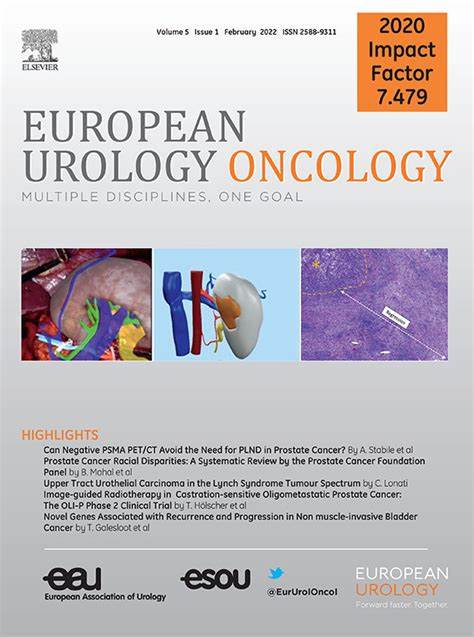Prostate-specific Membrane Antigen Positron Emission Tomography Before Reaching the Phoenix Criteria for Biochemical Recurrence of Prostate Cancer After Radiotherapy: Earlier Detection of Recurrences
IF 8.3
1区 医学
Q1 ONCOLOGY
引用次数: 0
Abstract
Background and objective
Biochemical recurrence (BCR) of prostate cancer (PCa) after curative radiotherapy (RT) is defined according to the Phoenix criteria, which is a prostate-specific antigen (PSA) rise of ≥2.0 ng/ml above the PSA nadir. Prostate-specific membrane antigen (PSMA)-based positron emission tomography/computed tomography (PET/CT) can identify PCa recurrences at very low PSA values. Our aim was to investigate the detection rate and extent of PCa recurrences using PSMA PET/CT after curative RT among patients with a PSA rise of ≥2.0 ng/ml above the nadir (Phoenix positive, Ph+) and patients not reaching this threshold (Phoenix negative, Ph−) and to compare therapeutic management and clinical outcomes in terms of time to androgen deprivation therapy (ADT) and castration-resistance PCa (CRPC), as well as overall survival.
Methods
We conducted a retrospective analysis of the Prostate Cancer Network Amsterdam (2015–2023) cohort of 568 patients who received curative-intent RT for PCa. Data on PSMA PET/CT outcomes, therapeutic management, and clinical follow-up were collected, including (re)initiation of ADT, progression to CRPC, and survival. Results were compared between groups using logistic regression and survival analyses.
Key findings and limitations
The study cohort comprised 222 patients (39.1%) classified as Ph− and 346 (60.9%) classified as Ph+. PSMA-avid lesions were detected in 170 Ph− patients (76.6%) and 322 (93.1%) Ph+ patients. In these groups, 75.9% of Ph− patients and 45.0% of Ph+ patients were eligible for local salvage therapy (odds ratio [OR 3.84]; p < 0.001). Distant metastases were less frequent in the Ph− group (n = 37, 21.8%) than in the Ph+ group (n = 157, 48.8%; OR 0.29; p < 0.001). Survival analyses revealed longer times to ADT (re)initiation and progression to CRPC, as well as lower overall mortality, in the Ph− group (log-rank p < 0.001). The retrospective study design is the main limitation.
Conclusions and clinical implications
For patients with PCa recurrence, PSMA PET/CT can detect this recurrence in the majority of cases not meeting the Phoenix criteria for BCR. Early imaging detects recurrences at a less advanced disease stage, allowing potential salvage treatments. In addition, early PSMA PET/CT is associated with longer times to ADT (re)initiation and progression to CRPC, as well as longer overall survival. These positive clinical implications warrant confirmation of our results in prospective studies to reduce potential leadtime bias.
Patient summary
We investigated early use of a special type of scan called PSMA PET (prostate-specific membrane antigen positron emission tomography) in patients with suspicion of recurrence of their prostate cancer after radiotherapy. Early scans can detect recurrence before the cancer progresses to a more advanced stage.
前列腺特异性膜抗原正电子发射断层扫描在放疗后达到凤凰城前列腺癌生化复发标准前的应用:更早地发现复发。
背景和目的:前列腺癌(PCa)根治性放疗(RT)后的生化复发(BCR)是根据凤凰标准定义的,即前列腺特异性抗原(PSA)比 PSA 低点上升≥2.0 ng/ml。基于前列腺特异性膜抗原(PSMA)的正电子发射断层扫描/计算机断层扫描(PET/CT)可以在 PSA 值非常低的情况下识别 PCa 复发。我们的目的是研究PSA升高≥2.0纳克/毫升的根治性RT患者(Phoenix阳性,Ph+)和未达到这一阈值的患者(Phoenix阴性,Ph-)之间使用PSMA PET/CT的检测率和PCa复发的程度,并比较治疗管理和临床结果,包括雄激素剥夺疗法(ADT)和阉割抵抗PCa(CRPC)的治疗时间以及总生存率:我们对阿姆斯特丹前列腺癌网络(2015-2023 年)队列中的 568 名接受治愈性 RT 治疗的 PCa 患者进行了回顾性分析。我们收集了 PSMA PET/CT 结果、治疗管理和临床随访数据,包括(重新)开始 ADT、进展为 CRPC 和生存率。采用逻辑回归和生存分析比较了各组之间的结果:研究队列中有222名患者(39.1%)被归类为Ph-,346名患者(60.9%)被归类为Ph+。在170名Ph-患者(76.6%)和322名Ph+患者(93.1%)中检测到了PSMA-avid病变。在这些组别中,75.9%的Ph-患者和45.0%的Ph+患者有资格接受局部挽救治疗(几率比[OR 3.84];P-组(n = 37,21.8%)高于Ph+组(n = 157,48.8%;OR 0.29;P-组(log-rank p 结论和临床意义):对于 PCa 复发患者,PSMA PET/CT 可以检测出大多数不符合凤凰城 BCR 标准的复发病例。早期成像可在疾病晚期发现复发,从而进行潜在的挽救治疗。此外,早期 PSMA PET/CT 与更长的 ADT(重新)开始时间、进展为 CRPC 的时间以及更长的总生存期相关。这些积极的临床意义需要在前瞻性研究中证实我们的结果,以减少潜在的前导时间偏差。患者摘要:我们研究了在放疗后怀疑前列腺癌复发的患者中早期使用一种名为 PSMA PET(前列腺特异性膜抗原正电子发射断层扫描)的特殊扫描。早期扫描可以在癌症发展到晚期之前发现复发。
本文章由计算机程序翻译,如有差异,请以英文原文为准。
求助全文
约1分钟内获得全文
求助全文
来源期刊

European urology oncology
Multiple-
CiteScore
15.50
自引率
2.40%
发文量
128
审稿时长
20 days
期刊介绍:
Journal Name: European Urology Oncology
Affiliation: Official Journal of the European Association of Urology
Focus:
First official publication of the EAU fully devoted to the study of genitourinary malignancies
Aims to deliver high-quality research
Content:
Includes original articles, opinion piece editorials, and invited reviews
Covers clinical, basic, and translational research
Publication Frequency: Six times a year in electronic format
 求助内容:
求助内容: 应助结果提醒方式:
应助结果提醒方式:


